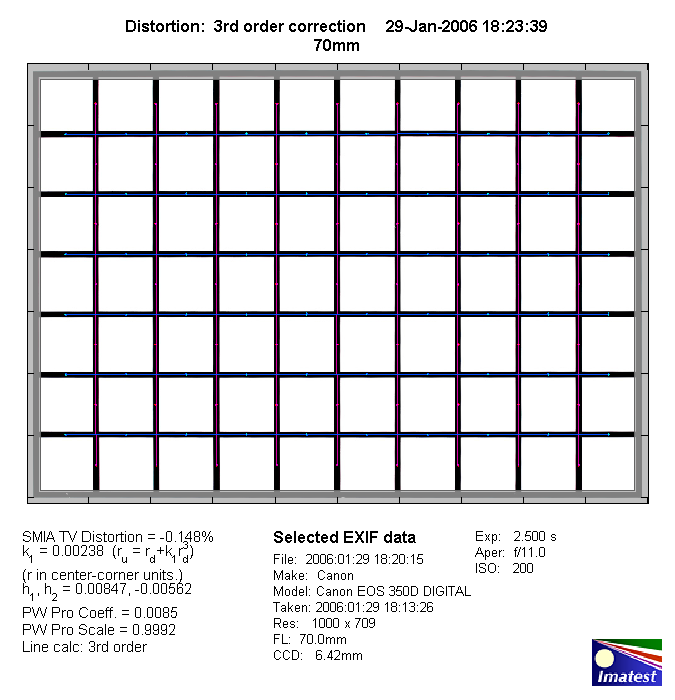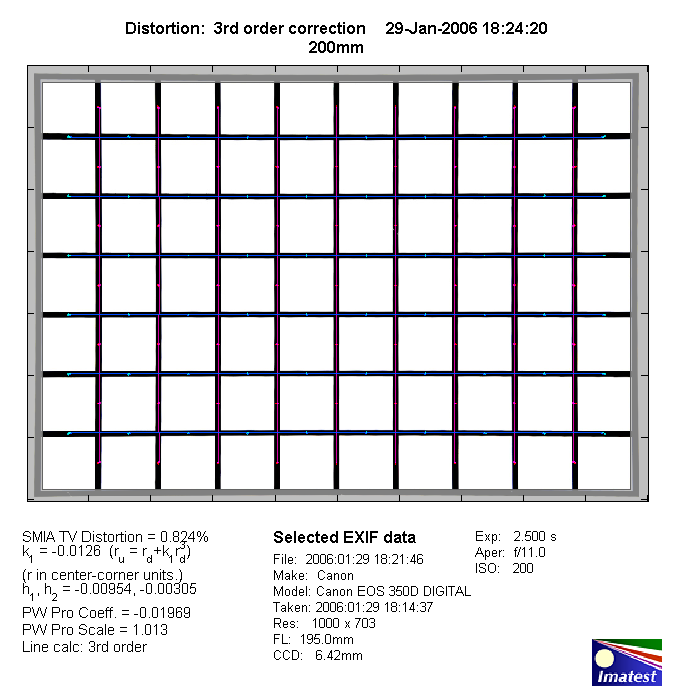|
Canon EF 70-300mm f/4.5-5.6 USM DO IS - Review / Lab Test Report - Analysis |
|
Lens Reviews -
Canon EOS (APS-C)
|
|
Page 2 of 2
Distortion
The level of distortion is quite low throughout the zoom range. Measured at a distance
of 40x focal length there is marginal barrel distortion at 70mm changing to slight
pincushion distortion at 200mm and 300mm.
70mm:

200mm:

300mm:

As usual you should probably expect more distortion towards closer focus distances.
Vignetting
Vignetting is very well controlled - at least on an APS-C DSLR which takes advantage
of the image center only (1.6x crop). Even at wide-open aperture it is nothing
to worry about in all but the most critical scenes. One stop down the issue disappears
to a negligible degree.

MTF (resolution)
The lens produced pretty impressive MTF figures reaching excellent center resolution
and very good borders at medium apertures. The performance is generally pretty
even across the zoom range except maybe at the weakest spot which is surprisingly
at 70mm f/4.5 rather than at the long end where we would typically expect this.
Please note that the MTF results are not directly comparable across the different systems!
Below is a simplified summary of the formal findings. The chart shows line widths per picture height (LW/PH) which can be taken as a measure for sharpness.
If you want to know more about the MTF50 figures you may check out the corresponding Imatest Explanations
Chromatic Aberrations
The lens produced a varying but quite low degree of chromatic aberrations (color shadows at
harsh contrast transitions) at the image borders. The average CA pixel width remains well
below 1 pixel at all focal length so it's usually nothing to worry about. At 300mm the
level is exceptionally low.

Other Observations
During the field testing the lens suffered from rather strong contrast reduction in contra light
situations - worse than with conventional lenses - so using the (optional) hood tends to be
a good idea.
In the initial market phase some users reported odd problems with the bokeh where onion-like
rings were visible in out-of-focus highlights. Due to the rather short testing period I can't
really tell for sure whether the problem was also present in the tested sample (purchased one
year ago). When looking at the sample bokeh below the far background has certainly smooth
out-of-focus highlights whereas to the front (towards the sharpness zone) the bokeh looks rather
agitated.

Sample Shots
I'm sorry, but I had remove this section due to an excessive increase in network bandwidth.
OpticalLimits will be migrated to a bigger server with unlimited network traffic in late February.
Verdict
In principal the Canon EF 70-300mm f/4.5-5.6 USM DO IS is a very interesting lens ... in principal.
From a performance point of view it delivers all that a consumer has hoped for - high resolution
figures in conjunction with low distortions, low vignetting and low chromatic aberrations and all
packaged in a quite sturdy, small package with high speed AF. So what is the problem ?
Well, it's the price tag. The optical performance of the new EF 70-300mm f/4-5.6 USM IS (non-DO)
is simply about as good. Mechanically it isn't quite in the same league as the DO lens but ... hey - it
comes at a 50% lower price tag! If we throw in the added values plus a little coolness factor
the DO lens may be worth a 200-250 EUR/$ premium over the conventional lens but at 1100 EUR/US$
it is simply way over-priced (also true for the EF 400mm f/4 USM DO IS). So unless
Canon reduces the price to something more in line with the (in-house) competition there're some
question marks whether the lens is really worth the extra financial sacrifice.
|